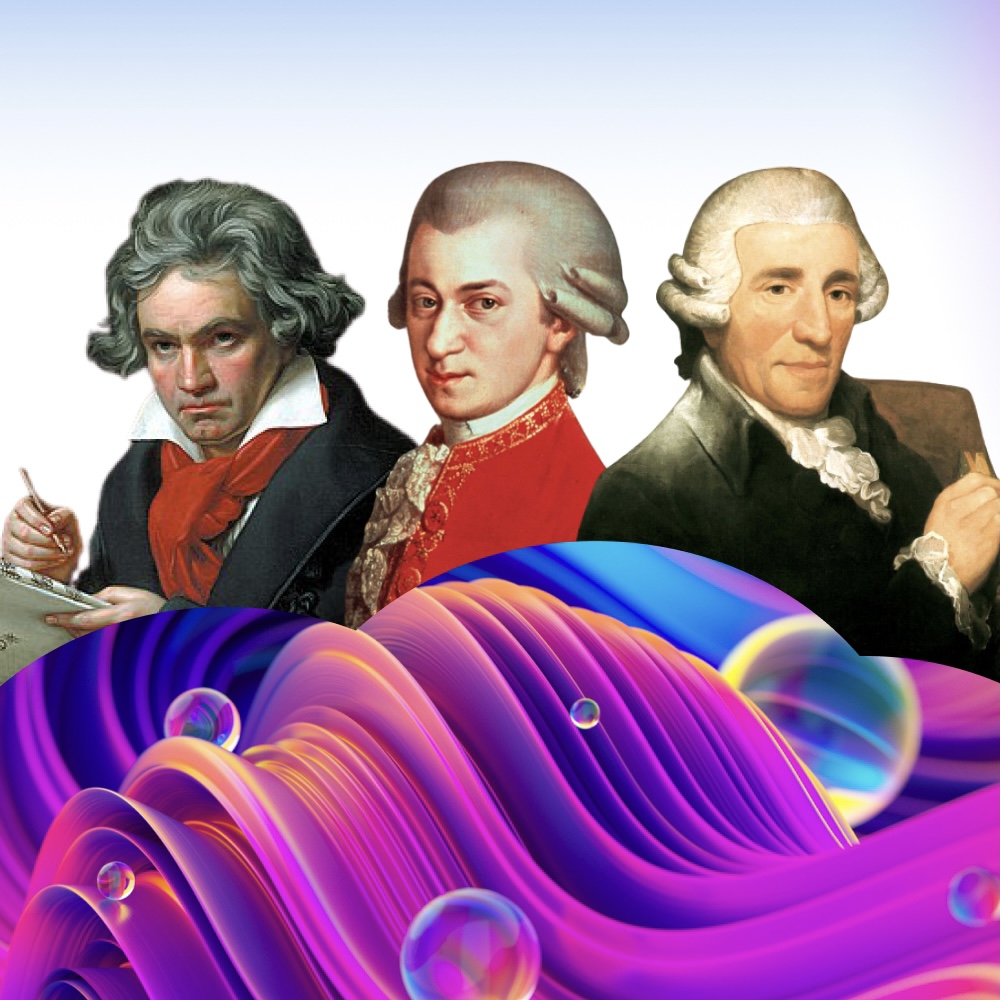
Beethoven Cycle: First Viennese School
Music of Haydn, Mozart, and Beethoven
Listen
Beethoven Cycle: First Viennese School
Franz Josef Haydn (1732-1809): Sinfonia from L’incontro improvviso
Wolfgang Amadeus Mozart (1756-1791): Symphony No. 31 in D major, K. 297 "Paris"
- Allegro assai
- Andante
- Allegro
Ludwig van Beethoven (1770-1827): Symphony No. 7 in A major, Opus 92
-
Poco sostenuto; Vivace
-
Allegretto
-
Presto; Assai meno presto
-
Allegro con brio
Learn
Program Notes by Charley Samson, copyright 2022.
Franz Josef Haydn (1732-1809): Sinfonia from L’incontro improvviso
Seven years before Mozart’s The Abduction from the Seraglio,
Haydn had composed his own “seraglio opera,” L’incontro improvviso (The Unexpected Encounter). It was first performed at Eszterháza on August 29, 1775 to celebrate the visit of Archduke Ferdinand, Habsburg governor of Milan and his consort Maria Beatrice d'Este. The libretto was based on a French opéra comique that Gluck had set in 1764 as La rencontre imprévue. Haydn’s opera features Turkish elements, including trumpets, drums and percussion, especially the triangle, in the opening Sinfonia.
Wolfgang Amadeus Mozart (1756-1791): Symphony No. 31 in D major, K. 297 "Paris"
Mozart had not composed a symphony in four years when, in June of 1778, Joseph Legros, the director of the Paris Concerts Spirituels, commissioned one. Mozart and his mother had arrived in Paris from Mannheim only three months earlier.
Mozart's Paris Symphony was introduced on June 18, 1778. The rehearsals were a trial. “Never in my life have I heard a worse performance,” he wrote to his father. “You have no idea how they twice bumbled and scraped through it.” At the actual concert, “the audience was quite carried away--and there was a tremendous burst of applause. I was so happy that as soon as the symphony was over, I went off to the Palais Royal, where I had a large ice.”
Legros said that “this was the best symphony ever written” for the Concerts Spirituels. He then asked for a new second movement, as he found the first version too long. Mozart duly supplied a new second movement for the second performance in August. “Each is right in its way,” he said, “for they have different characters; however, I like the second still better.”
Commentators disagree on what influences are at work in the symphony. Alfred Einstein says that it is “characteristic of the Mannheim-Paris style. In the first movement it even parodies that style to a slight degree.” It begins with a precise unison attack by the strings, an effect much boasted by the Parisian orchestra. “What a fuss the oxen here make of this trick!” said Mozart. “The devil take me if I can see any difference! They all begin together, just as they do in other places.”
The opening movement also features “pompous runs in the strings characteristic of the French overture,” writes Einstein, and “impressive unison passages for the strings against sustained tones in the winds. But that is where the parody, or the connivance to please the French taste, ends. Mozart's ambition was far too great, and there was too much dependent on the success of the work, for him not to take it seriously. The fact that the last of the three movements was the most successful does honor to the taste of the Parisians. The second theme of this movement is a fugato, supplying the natural material for development; it does not return in the recapitulation--one of the strokes of genius in this masterful movement, which hovers continually between brilliant tumult and graceful seriousness.”
Jens Peter Larsen calls the work “the first fully mature symphony in the Viennese classical style.” But H.C. Robbins Landon writes: “It is not really a Viennese classical symphony at all, but rather a conscious attempt to write an orchestral work in the grand Mannheim style.”
Ludwig van Beethoven (1770-1827): Symphony No. 7 in A major, Op. 92
Beethoven's Seventh Symphony was completed in the late spring or early summer of 1812. It wasn't performed publicly until December 8, 1813 at a concert in Vienna to benefit wounded Austrian and Bavarian soldiers. Also on the program was Beethoven's Wellington's Victory.
Beethoven himself conducted. The composer Ludwig Spohr described the scene: “The execution was quite masterly, despite the uncertain and often ridiculous conducting of Beethoven…. It is a sad misfortune for anyone to be deaf; how then should a musician endure it without despair? Beethoven's almost continual melancholy was no longer a riddle to me.”
A review of the concert reported that the Symphony “deserved the loud applause and the exceptionally good performance it received…. This symphony…is the richest melodically and the most pleasing and comprehensible of all Beethoven symphonies.” Beethoven regarded the Seventh as “among my best works.”
Not everyone shared Beethoven's opinion. After a performance in Leipzig, Clara Schumann's father suggested that the music could only have been written by someone who was very, very drunk. When the Seventh was played before the Congress of Vienna in 1814, Carl Maria von Weber remarked that Beethoven was “now quite ripe for the madhouse.” Twelve years later, Weber conducted the London Philharmonic's performance of the Beethoven Seventh. Apparently Weber had changed his mind about the piece.
It was Wagner who dubbed the Seventh “the apotheosis of the dance, the dance in its highest condition, the happiest realization of the movements of the body in ideal form.” He wrote: “If anyone plays the Seventh, tables and benches, cans and cups, the grandmother, the blind and the lame, aye, the children in the cradle, fall to dancing!” Wagner once demonstrated his theory by dancing to the Seventh Symphony, accompanied by Franz Liszt at the piano.
“It would require more than a technical yardstick to measure the true proportion of this Symphony--the sense of immensity which it conveys,” writes John N. Burk. “Beethoven seems to have built up this impression by willfully driving a single rhythmic figure through each movement, until the music attains (particularly in the body of the first movement, and in the Finale) a swift propulsion, an effect of cumulative growth which is akin to extraordinary size.”
After a long introduction, the opening movement launches into a persistent rhythmic propulsion that Ernest Walker found virtually unparalleled elsewhere. The second movement, according to Marion M. Scott, is “marvelous…full of melancholy beauty.” Beethoven's biographer Alexander Thayer says the trio of the third movement is based on an Austrian pilgrims’ hymn. In the Finale, George Grove discovered “a vein of rough, hard, personal boisterousness, the same feeling which inspired the strange jests, puns and nicknames which abound in his letters.”
Engage
We Are...
Gratitude
Thank you to our family of financial supporters!
DIAMOND
Linda Fetterman
PLATINUM
Bill & Ann Boettcher
Michael & Carol Minelli Foundation
Kenneth & Myra Monfort Charitable Foundation
Stapp Interstate Toyota
Harvey & Carol Yoakum
GOLD
IBM Corp Matching Grants
Judith Watson
SILVER
Mary Brittingham
Dominic Capuano
Bank of Colorado
Lynn & Helen Clark Fund
Kim Cutler
Drain Away Fast Rooter
Thomas & Sandra Hoog
Horsfall Family Foundation
Jesse & Tyler Jenner
Richard & Darcy Juday
Stevan & Jan Kukic
Dr. Rowlin Lichter
Robert & Ann Parsons
Doug & Karen Ward
BRONZE
Catherine Beeson
William & Nancy Berry
Martha Dicks in memory of Gary Dicks
Gustav Fingado
Joel Buck-Gengler
Tina Davis Studio
Sally & Stephen Foss
Carol & Tony Keig
Connie Lehman
Michael Maloy
Medtronic Grant Funds
James Mitchell
Sarah Snyder
Margaret Spangler
Susan Thayer
COPPER
Kelvin Akeson
Debbie Arnold
Peggy Arnold
John Becker
Shari Burnham
Rhonda Burtz: In memory of Ruth Howe
Thomas Castellano
Leslie Cerezo
Joyce Costello
Karen Coupland
Tom Cowing
Karen Cumbo
Isaac Davenport
Marvin & Ruthanne Dirks
Shirley Dodge
Mary Faini
Laurie Faye
Charlene Gearing
Hazel Gordon
Tammy Hall
Craig Hirota: In memory of Michael Hirota
Kristen Hirota
Sarah Houghton
Elaine Keiser
Barry Knapp
Carol Krismann
Roger Lange
Hugo Leon
Mary Anne Lessley
Mary Seufert Goodhue: In memory of Michael Hirota
Mary Mahlendorf
Vrinda McGinnis
Mackenzie Merrill-Wick
Joel Meyers: In memory of Michael Hirota
Kay Miller
Karen Moore
Kenneth Moran
Rich & Kim Plumridge
Iris Rattenborg: In memory of Alan Seaman
Kathleen Regan: In memory of Michael Hirota
Paul & Diane Rickard
Susan Roach
Giselle Roedel
Janice Sacherer
Dick Saiki
Jessica Schmitt
Fred Schulerud
Marjorie Seaman: In memory of Alan Seaman
Robert Stahly
Janet Stinson: In memory of Michael Hirota
Philip Straffin
Thomas Strauss
Leona Stoecker
Alice Sueltenfuss
Ann Tatnall
Lisa Tellier
Linda Weber
Mary Lou Wigley
Susan Wise
Phillip Wong
Carol Worthman
Robert Worthman
Bill Wysocki
Pat Young





